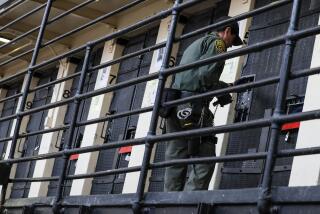Vindication for Victims’ Families : Crime: Harsh words from angry relatives and the jurors who called for Randy Kraft’s death accompany the sentence of the mass murderer.
- Share via
SANTA ANA — Darwin Hall traveled all the way from Idaho to watch Randy Steven Kraft’s face as he was sentenced to die for the savage sex murder of Hall’s son and 15 other young men in Orange County.
And Hall wasn’t about to leave without getting the last word.
As the audience struggled to its feet after court was dismissed Wednesday morning, the heavy-set Hall stood up and shouted, “Burn in hell, Kraft! Turn around and look!”
The last line was a reference to Kraft’s habit of scanning the audience during his 13-month trial, and several people clapped in appreciation of the outburst.
It was a day of vindication for the relatives of Kraft’s victims and the jury who convicted him, as Superior Court Judge Donald A. McCartin strongly rejected appeals to hold a new trial for the 44-year-old computer consultant from Long Beach.
“It’s been a long time,” said Hall, of Pocatello, Ida., whose son Mark Howard Hall’s sexual torture and murder was cited by McCartin as reason enough to send Kraft to the gas chamber. “He killed Mark 13 years ago. I hope this ends it.”
Several relatives of murder victims admitted feeling chilled when Kraft asked to speak before McCartin announced his decision. It was the first time Kraft had addressed the question of his guilt, and he said in a clear, even tone of voice: “I have not murdered anyone, and any reasonable review of the record will show that.”
Rodger DeVaul Sr., whose son was killed by Kraft in 1983, said the remark was typical of him.
“I expected him to say something like that,” DeVaul said. “What could he say? I was surprised he could talk, the animal that he is.”
Besides the families of Kraft’s victims, Wednesday’s sentencing also attracted 10 of 12 jurors in the case and one alternate juror, all of whom lived with the case for more than a year.
“All of us felt so strongly about being here,” said juror Carol Neal. “We’ve been in constant contact with the bailiff to keep up to date (on the proceedings).”
As for Kraft’s statement, Neal said: “I was ready, waiting to see what he had to say. I think he really thinks he is innocent. He has no remorse, he has nothing.”
Jury foreman Jim E. Lytle said he wasn’t spooked by Kraft’s remark. “He doesn’t give me the creeps no more,” Lytle said. “This was his show. That’s just the way he is.”
Judge McCartin’s handling of the sentencing hearing drew praise from both jurors and relatives of Kraft’s victims. McCartin expressed revulsion at the torture and mutilation Kraft inflicted upon his victims, singling out the case of Mark Hall, who was castrated and burned extensively with a cigarette lighter before his death.
After the judge announced his decision, McCartin told Kraft about two letters he had received from families in Corona del Mar and Iowa inquiring about whether missing relatives were on the infamous hit list of 61 to 65 victims recovered from the trunk of Kraft’s car.
“You might give some thought in your waning moments to helping those people out,” McCartin told Kraft.
Judy Nelson, whose son was killed by Kraft, said she appreciated McCartin’s comments.
“I loved him for it,” Nelson said. “I wanted to get up and give him a kiss.”
Although the direct involvement of jury members and the families of Kraft’s victims ended with Wednesday’s sentencing hearing, the case is far from being resolved. The death sentence will be automatically appealed and is certain to remain in the court system for at least several years.
“It’s not over yet,” said juror Alfred Embrey. “It’s over when whatever happened to (the victims) happens to him.”
APPEALING THE DEATH PENALTY
According to experts in capital cases, it could take 10 years for Randy Steven Kraft’s appeal of his death sentence for 16 Orange County murders. Here is why:
Years 1 to 2:
The state Supreme Court must appoint an appellate attorney. First, the California Appellate Project, a private group that contracts with the high court, screens and recommends a lawyer. The high court almost always appoints the CAP-recommended attorneys, usually two.
The attorneys then review the record, and file a motion for a corrected copy of the record. This is no small task. Almost all court reporter records contain minor misspellings, commas out of place, etc. Often the defense will note that a particular pretrial hearing was inadvertently left out altogether.
It can take two years just to get an accepted copy of the trial transcript. Since Kraft’s trial was about three times longer than most death penalty trials, the transcript is much longer. One appellate specialist predicted that it would take three years before Kraft’s defense is ready to file its first brief with the state Supreme Court.
Years 3 to 4:
The defense then files a brief asking the state Supreme Court to order a new trial and reduce the death verdict. The attorney general must respond, and the defense files a rebuttal. In some cases, the attorney general files a re-rebuttal.
The case cannot be set for a hearing by the state Supreme Court until all the briefs are completed.
Years 5 to 6:
Before the state high court hears the case, so much time has usually elapsed that the defense requests the right to file a supplemental brief. The attorney general then must respond to the supplemental brief.
The court then hears oral arguments on the case. In the past, it has been a year or more between oral arguments and decision. The current Supreme Court has vowed to shorten that time.
If the death sentence is upheld, the defense usually files a petition for rehearing. That has always been denied.
Years 7 to 10:
The defense next appeals to the U.S. Supreme Court. If that court denies the request, the defense then returns to the state courts with a writ of habeas corpus, claiming errors by the federal court.
Many defense lawyers file this writ with the trial judge. It then goes to the state appellate court, and finally to the state Supreme Court.
If the state Supreme Court denies this writ, the defense then files an appeal with the U.S. District Court Central division in Los Angeles. If denied, the case then goes to the U.S. 9th Circuit Court of Appeal, and finally back to the U.S. Supreme Court.
If this fails, the case goes before the governor of California for a clemency review. If that fails, the only thing left is an eleventh hour appeal to any court that will hear it.
More to Read
Sign up for Essential California
The most important California stories and recommendations in your inbox every morning.
You may occasionally receive promotional content from the Los Angeles Times.










